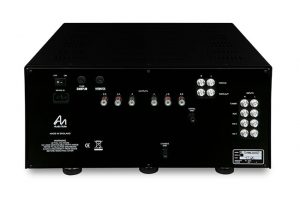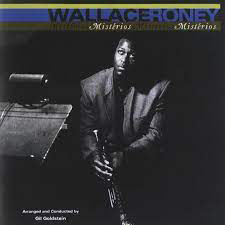Audio Note Meishu Phono 300B Tonmeister SE Integrated by Clement Perry

 My first-time encounter with Audio Note of UK electronics happened fortuitously at my very first Hi-Fi show. If my memory serves me correctly, this was in the early ’90s, during hi-fi’s golden years – right here in New York City. I don’t remember its sound for the life of me because I believe it was only a static display; nevertheless, that burnished copper chassis captured me alongside its $200k asking price. Despite its stunning appearance, the REAL reason I never forgot this encounter was because of its cost. The amount of this 45-watter was more than the bank was offering me to purchase my home. The thoughts, feelings, and the notion that some unfortunate soul would spend so much on a 45-watt amplifier baffled me. That encounter started an inner dialogue with myself that lasted for years to come. Keep in mind; since this was a static setup, I had no reference on what this $200k amp could do.
My first-time encounter with Audio Note of UK electronics happened fortuitously at my very first Hi-Fi show. If my memory serves me correctly, this was in the early ’90s, during hi-fi’s golden years – right here in New York City. I don’t remember its sound for the life of me because I believe it was only a static display; nevertheless, that burnished copper chassis captured me alongside its $200k asking price. Despite its stunning appearance, the REAL reason I never forgot this encounter was because of its cost. The amount of this 45-watter was more than the bank was offering me to purchase my home. The thoughts, feelings, and the notion that some unfortunate soul would spend so much on a 45-watt amplifier baffled me. That encounter started an inner dialogue with myself that lasted for years to come. Keep in mind; since this was a static setup, I had no reference on what this $200k amp could do.
The Stereo Times launched in the spring of ’99. In the many years since – it has allowed me to travel to some pretty far-out places. As a result, my thoughts and insights on what constitutes state-of-the-art two-channel performance have changed dramatically; the more I became exposed to some of the most renowned two-channel setups available in the world today. I am no longer that neophyte who walked into that New York Audio show nearly thirty years ago.
My first-time “Ah-Ha” moment occurred around ’09 with Audio Note distributors Mike and Neli of the Audio Federation fame (I’ve encountered AN (UK) at other shows but still couldn’t detect what made them so special). If my memory serves me correctly, I think this was during the Rocky Mountain Audio Fest, and fortunate for me, this was not a static display. The setup, hosted by a husband and wife team that knows a thing or two about sonic excellence, also featured the tall and statuesque four-piece Marten Design Coltrane Supreme speaker system, which dominated the room with its ultra-elegant look and finish. In between these monoliths were some very high-priced AN of United Kingdom electronics glowing ever so seductively (herein AN (UK). I immediately became excited. Until now, I’ve never seen AN (UK) electronics in a mix n’ match scenario powering anything but AN (UK) loudspeakers. As a result, I was immediately intrigued to discover how fast this modestly powered (50-watts?) design would fare handling this not-so-easy load (I think the Marten Coltrane is rated at only 91 dB). This system’s quality was unmistakably stellar in terms of price and appearance, but how good could this setup reproduce the music? Fortunately, there was hardly anyone in this rather large suite so, I took a seat center, maybe the second-row, and felt as though I was staring into a kaleidoscope as soon as the music started. The colors that began pouring forth, the authenticity and shimmer of instruments, the tonal majesty just drove me out of my seat. Unashamedlessly, I got up and started dancing and singing. This dear reader was not supposed to happen in settings like showrooms. Yet, it’s what happens whenever the music connects with my soul. Under show conditions, this was a first!

Since that soul-stirring, near psychedelic experience, I’ve placed Audio Note of UK on my three-item bucket list (Audio Consulting of Switzerland and FM Acoustics), which hasn’t grown since 2005. Of course, since that first-time encounter, I found myself looking for Audio Note UK whenever I am at an audio event. Through our many talks and discussions over the years, Peter Qvortup, Audio Note of UK’s long-time president, finally asked that I audition some of his world-renowned electronics in my own listening space. I cannot tell you how delighted and fearful I felt at the same time. Suppose it doesn’t agree with the Tektons or cabling? What if it doesn’t create the synergy I expect when playing the wonderful-sounding HiFi Rose RS150 Network Music Streamer that just arrived? Trusting Qvortrup’s judgment, he felt the Audio Note Meishu Phono 300B Tonmeister would be a perfect start on its own (herein Meishu Tonmeister). I wholeheartedly agreed and couldn’t wait for its arrival. Some weeks later, a giant carton arrived via FedEx with Audio Note UK inscribed on it.
The Meishu Tonmeister arrived smartly packaged, draped in protective heavy-duty foam garb. Inside I found an owner’s manual, a pair of white gloves, and tucked in smaller boxes were the necessary vacuum tubes. Installing the tubes proved easy-peasy compliments of the owner’s manual denoting their placement. It was a cinch getting the Meishu Tonmeister up and running despite being a bit nervous at the idea of not having a tube amplifier in-house for some time.

Audio Note (UK) ’s website states, “the Meishu Integrated Amplifier is a Pure Class-A, Singled Ended valve amplifier that uses the highly regarded 300B direct heated triode valve, producing a level of performance that is radically superior to the vast majority of current designs. Reading further, I discovered three different Meishu Tonmeister levels that come with or without phonostage (Standard, Silver, and Signature). For those who might decide on a dedicated phono-section, the Line-stage Meishu Tonmeisters are available. In terms of appearance, one can choose between the Anodized Aluminum or Black Acrylic chassis. Both are attractive, but the Black Acrylic is my personal favorite. Sporting four gold-plated control knobs (Function, Record, Balance, and Volume), the Meishu Tonemeister has the appeal of its legendary predecessors. Looking from the rear shows the Meishu Tonmeister as a well-thought-out integrated design boasting an input selection that includes Tuner, Aux, CD1 CD2, Tape-In and Tape Out, and Phono. Centered on its rear is a beautiful trio of the company’s five-way speaker terminals that allow for specific 4 Ohm and 8 Ohm operations. Power IEC toggle switch and ground pin complete the rear section of the Meishu Tonmeister.
Internally, the Meishu Tonmeister comprises elegant simplification, thanks partly to AN of the UK’s ability to build matched transformers in-house. Arguably, 300B SE vacuum tubes are among the most musical pedigree for harmonic and tonal shading. That’s why Qvortrup mainly chose the 300B for Meishu Tonmeister above any other. Additionally, the company’s custom-built resistors, foil capacitors, electrolytic capacitors, and specially-chosen tube circuitry elevates the sound beyond its $15,740.00 asking price.

A pair of 300B tubes (Psvane Hifi Series) are complimented with dual 5687 and 6X5 vacuum tubes. The linestage section uses current production ECC82/12AU7 Psvane, while for the phono section, Qvortrup chose ECC83/12AX7 Psvane tubes. The 2nd stage uses ECC88 (Psvane), 6DJ8 (New Old Stock herein NOS), and 6N23P (Russian NOS). The Tonemeister’s driver section is composed of a 5687WB (US-made NOS). The newly developed power supply uses only one mains transformer, one 5U4 rectifier valve, and one choke. Qvortrup maintains that “when this arrangement is optimized, it works extremely well, producing a very homogeneous and ‘complete’ sound.”
 To be fair, I was somewhat taken aback when I found the AN of UK Tonmeister has a rated output of 8-watts per channel. Before making false assumptions about how much this fly-weight champion could box outside its weight, I simply strapped it up to a pair of highly sensitive (98dB! 8-Ohm load!) Tekton Double Impacts SE’s. First up through the HiFi Rose RS150 Network Music Streamer (under review) was the profoundly contemplative and melancholic Meu Menino by the late great trumpeter Wallace Roney, from his ’94 classic CD “Misterios,” (who on March 31, 2020, sadly passed away from complications arising due to Covid-19). This remarkable date has a Gil Evans-like feel that features Gil Goldstein as conductor. His orchestra performs ever so delicately behind Roney’s quintet (Geri Allen, Ravi Coltrane, Antoine Roney, Clarence Seay, and Eric Allen). A recording such as this, with this many musicians, could have easily overwhelmed this studio recording. I also noticed that Teo Macero received some credit as one of the producers of this recording. For me, there are a few hints of Miles Davis’ Sketches of Spain here, which Teo Macero produced back in 1960. Much to my surprise, the 8-watt Meishu Tonmeister did not fuss or flinch. It did the opposite and simply communicated this recording in a way I had not experienced before.
To be fair, I was somewhat taken aback when I found the AN of UK Tonmeister has a rated output of 8-watts per channel. Before making false assumptions about how much this fly-weight champion could box outside its weight, I simply strapped it up to a pair of highly sensitive (98dB! 8-Ohm load!) Tekton Double Impacts SE’s. First up through the HiFi Rose RS150 Network Music Streamer (under review) was the profoundly contemplative and melancholic Meu Menino by the late great trumpeter Wallace Roney, from his ’94 classic CD “Misterios,” (who on March 31, 2020, sadly passed away from complications arising due to Covid-19). This remarkable date has a Gil Evans-like feel that features Gil Goldstein as conductor. His orchestra performs ever so delicately behind Roney’s quintet (Geri Allen, Ravi Coltrane, Antoine Roney, Clarence Seay, and Eric Allen). A recording such as this, with this many musicians, could have easily overwhelmed this studio recording. I also noticed that Teo Macero received some credit as one of the producers of this recording. For me, there are a few hints of Miles Davis’ Sketches of Spain here, which Teo Macero produced back in 1960. Much to my surprise, the 8-watt Meishu Tonmeister did not fuss or flinch. It did the opposite and simply communicated this recording in a way I had not experienced before.
Wallace’s muted trumpet possessed a level of harmonic purity and simplicity that was so realistic I sometimes felt like being in front of the real thing, albeit from a more distant perspective. Wallace’s embouchure had more fluidity through his mute, much like of his hero Miles Davis. I simply heard more breathing and spit flowing through his instrument. The overall scale and expansive breadth of the Meishu Tonemeister felt far more potent than its modest rating. The volume was more than adequate as it filled my downstairs listening space with neither stress nor strain. I’m convinced vacuum tubes either clip more delicately and/or have more power than their solid-state counterparts. The improved tonal acuity, harmonic richness, and see-through ability offered by the Meishu Tonmeister were simply stunning. The sound of instruments never sounded so correct and authentic through the Tektons previously. I had expected this from the level-five Audio Note series – not from this mid-3-level series performer. Through the Meishu tonmeister, my go-to for outstanding female voices in artists like; Ella, Dianne Reeves, Betty Carter, Roberta Flack, and Shirley Horn were all presented with a harmonic and tonal realism I had never experienced prior. The Meishu Tonmeister is just as adept at capturing great male jazz vocalists, whether it’s Joe Williams alongside Count Basie and his big band orchestra or Gregory Porter singing acapella. Being an admirer of high-power solid-state designs, I would have never guessed the level of sheer excellence from an 8-watt vacuum tube-based amplifier.
It’s easy to seduce this writer when you aim straight at the heart of the music – which is the midrange. The Meishu Tonmeister does such a fantastic job that there is no desire to stress the frequency extremes. Again, the highs are ever-so delicate, while the bass is surprisingly adept. I don’t hear any emphasis (or the lack thereof) due to its low-power rating of only 8-watts per channel. However, what I do enjoy immensely is the steady continuity of its unparalleled rhythmic flow. I will admit openly and honestly, noting the low-power rating; I did not attempt to play the music louder than necessary. Fortunately for me, the Tekton Double Impact SE’s gave the Meishu Tonmeister more musical prowess than I would have thought possible.
 To hear the Meishu Tonmeister perform at such a high level, no matter the type of material (90% jazz), was an eye-opener. I expected this type of performance from their top-tier electronics. This is now possible from Audio Note (UK) at a tenth of their level-five electronics asking price is excellent news indeed. That it is manufactured by Audio Note (UK) should serve as an added incentive of build quality and craftsmanship. Of course, this also makes me wonder just how much better are their upper-crust components? I shudder to think.
To hear the Meishu Tonmeister perform at such a high level, no matter the type of material (90% jazz), was an eye-opener. I expected this type of performance from their top-tier electronics. This is now possible from Audio Note (UK) at a tenth of their level-five electronics asking price is excellent news indeed. That it is manufactured by Audio Note (UK) should serve as an added incentive of build quality and craftsmanship. Of course, this also makes me wonder just how much better are their upper-crust components? I shudder to think.
Unfortunately, due to the Covid-19 virus, the world went into a sudden shutdown, preventing me from inviting my friends over for some feedback. Luck shined its light once again because Qvortrup has just informed me that a pair of AN loudspeakers is scheduled to arrive any day! With the Covid-19 vaccine available (got mine!) and the lowering of social distancing restrictions here in NJ, I can finally have the guys over to scrutinize this sonic marvel further. I wonder if they’ll become as bedazzled over the Tonmeister as quickly as I did. Stay tuned!


![]()


clement perry
SPECIFICATIONS:
Price: $15,740.00
1 x 5U4G
without notice.
Audio Note (UK) Ltd,
Stereo Times Masthead
Publisher/Founder
Clement Perry
Editor
Dave Thomas
Senior Editors
Frank Alles, Mike Girardi, Russell Lichter, Terry London, Moreno Mitchell, Paul Szabady, Bill Wells, Mike Wright, and Stephen Yan,
Current Contributors
David Abramson, Tim Barrall, Dave Allison, Ron Cook, Lewis Dardick, John Hoffman, Dan Secula, Don Shaulis, Greg Simmons, Eric Teh, Greg Voth, Richard Willie, Ed Van Winkle, Rob Dockery, Richard Doran, and Daveed Turek
Site Management Clement Perry
Ad Designer: Martin Perry





Be the first to comment on: Audio Note Meishu Phono 300B Tonmeister SE Integrated by Clement Perry